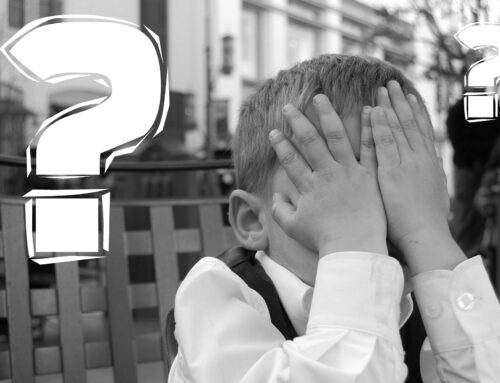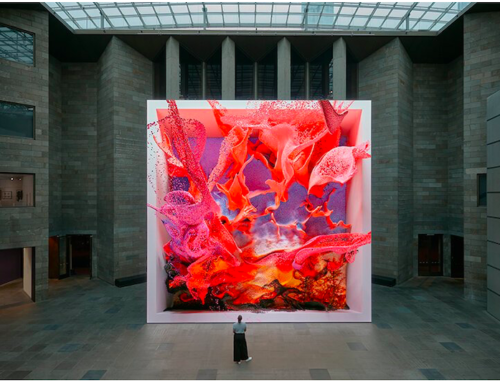There is sufficient experimental evidence to suggest it’s time we ditched our ‘Classical worldview.’ Time crystals and Entanglement invite us to adopt a ‘Quantum mindset.’
It is often said that quantum physics turned everything we thought we knew about the nature of reality on its head. Why doesn’t it seem like that, then? Why hasn’t quantum physics profoundly changed the way we view reality? Why do we insist on the outdated and limiting ‘Classical worldview’?
By Classical worldview, I refer to the ‘common-sense’ assumptions that: (1) everything that happens has a cause; (2) causes precede happenings; (3) ‘interaction’ implies objects are in physical contact; (4) events occur ‘in time,’ i.e., events have a beginning, middle, and end; and, (5) time is linear, i.e., there is such a thing as the past, present, and future. In other words, the Classical worldview is the background assumption that the universe operates like some kind of sophisticated machine – like an enormously complicated clock.
In this piece, I talk a little about entanglement and time crystals. Entanglement is the physical phenomenon that proves things don’t need to be anywhere near each other to cause an effect; and, time crystals are the physical phenomenon that prove events can occur ‘out of time,’ i.e., spontaneously and without antecedent. Now, the physical experiments that prove the existence of entanglement and time crystals bring with them a truckload of metaphysical baggage!
Entanglement suggests one of two things: either signals can be sent faster than the speed of light, or ‘spooky action at a distance.’ Whichever of these explanations you prefer, Einstein’s theory of special relativity is in trouble. Einstein maintained that ‘events’ or ‘time’ – in the context of the universe – were ‘relative,’ depending on where you were standing. That is to say, an event on Mars does not happen at the ‘same time’ on Earth. Einstein discovered it takes ‘time’ for information about the Mars event to reach you, on Earth. Special relativity, therefore, is based on two fundamentals: (1) the fabric of space; and (2) the speed of light. Events don’t happen simultaneously everywhere in the universe because an ‘event’ has to cross the fabric of space to reach you and nothing travels faster than the speed of light.
But wait a moment! For entanglement to take place, one of the two fundamentals of special relativity must be contradicted: either the two particles are in contact irrespective of the fabric of space, or, the particles send a signal faster than the speed of light. In other words, scientists have now proven experimentally – that is to say reliably, repeatably, and demonstrably – that, at a fundamental level, the universe it not ‘universally’ relativistic. Albert Einstein was wrong – or, at least, he was less right than people assume.
So, what?
Ok, fine. The universe isn’t universally relativistic and the clockwork picture of the universe is bunk. So, what? Well, I argue if we – and I’m talking here about the average Joe on the street, not just academics or elites – abandoned the Classical worldview our lives would be a heck of a lot more enjoyable. Imagine a world in which time and causation were not held in such high esteem. Now, that is not to suggest we adopt the naïve view that time and causation don’t matter – rather, it is to say we stop allowing these two ideas to structure our lives. Linear time can be used to ‘coordinate’ human activity, but it’s not ‘real.’ Causation can be attributed, but only in an artificially controlled environment. For example, in an experiment with a perfectly flat surface and two billiard balls, I can safely say that the collision of one ball ‘caused’ the movement of the other. However, imagine we are trying to accurately identify what ‘caused’ 9/11? It’s possible, of course, to suggest various historical ‘factors’ or to point to possible ‘influences,’ but, in a social setting, the attribution of definitive, specific causes, in anything other than a rhetorical sense, becomes impossible – becomes meaningless.
Quantum Mindset
Instead of a Classical worldview, what I’m advocating is a ‘quantum mindset.’ A mindset where the banal past–present–future trope has been retired. A world where all there is, is an endless present. A world where we stop looking at event-A followed by event-B, and assuming it’s the cause of event-C. A reality where we relaxed into the overwhelming uncertainty and possible spontaneity that constitutes events in our lives. I believe a quantum mindset is far more peaceable and would lead to greater contentment because people would finally relinquish the illusion of control, and release themselves from the baggage of the past and expectations for the future.
Now, perhaps what I’ve proposed doesn’t sound all that radical or revolutionary. It’s true many forms of spiritualism have been prescribing a similar approach to life for centuries – if not millennia. The difference with the quantum perspective is that while people who consider themselves rational, scientific, and profoundly logical can brush aside those ‘traditional’ systems with the dismissive epithet, “but, that just isn’t Real,” the same can’t be said of the quantum mindset. In fact, it’s probably more ‘real’ to say that people who hold dogmatically to the Classical conception of reality are like the Ptolemaists of old in the face of the Copernican revolution: they refuse to let go of outdated ideas and embrace the latest science.
Therefore, in defence of, and to substantiate the quantum mindset, let me describe the recent experiments that confound our arbitrary concepts of space, time, space-time, and causation.
Time Crystals
In 2012, Nobel laureate Frank Wilczek, wrote a paper titled, Quantum Time Crystals. The paper asked whether time-translation symmetry could be “spontaneously broken in a closed quantum-mechanical system?” In other words, can events occur ‘out of time’? Wilczek theorised it was indeed possible, and posited a new ‘phase’ of matter called a time crystal that could emerge spontaneously from a system when the ground state was at the lowest possible level of energy.
A traditional crystal is a physical entity composed of a repeating pattern or configuration in ‘physical space’; a time crystal is an emergent pattern of repeating motion or oscillation. The motion-pattern of a time crystal, however, is context independent, and not in equilibrium with its environment. This puts time crystals at odds with the laws of electrodynamics.
It wasn’t until five years later that Wilczek’s theory was observed in a laboratory setting. In 2017, two teams – one operating out of the University of Maryland, and the other from Harvard – observed the spontaneous emergence of a time crystal. The following year, Samuli Autti and the team from Aalto University in Finland succeeded in controlling time crystal transformation. Then, in 2020, Autti and the team generated two time crystals, encouraged their interaction, and observed that time crystals remain phase coherent.
In case the significance of time crystals is unclear, we have an example of an un-caused cause: a phenomenon for which there is no attributable cause. The time crystal emerges spontaneously and produces a phase of energy out of equilibrium with the state from which it emerges. However, the Classical worldview is underwritten by science as the ‘discovery of causes in nature,’ and, by extension, therefore, anything for which there is no cause is deemed super-natural. But, time crystals aren’t supernatural, and they definitely exist. So, maybe, just maybe, there’s something awry with the Classical worldview.
Entanglement
Entanglement, first theorised by Erwin Schrödinger in 1935, is arguably the ‘oldest’ of strange quantum phenomena. Entanglement implies a particle and its ‘twin,’ whereby a measurement (i.e., an observation or determination of some attribute) of one particle simultaneously affects the outcome of the measured twin. What is most profound about entanglement is that the ‘switch’ between one entangled particle and another occurs simultaneously, i.e., instantaneously. In other words, whatever signal is sent from one particle to the other is sent across space at a speed ruled out by special relativity – i.e., faster than the speed of light. Furthermore, particles don’t even need to be anywhere near each other to exert this influence. One explanation for this observation is that signal switching between entangled particles operates not only faster than the speed of light, but also as though there was no space-time between them. In other words, even if particle-A was in London and particle-B in Sydney, for all intents and purposes the two particles might as well be nested within one another – they may as well occupy the exact ‘same’ location.
Ironically, entanglement is a long-proven phenomenon. The first entanglement experiment took place in 1972, when Stuart Freedman and John Clauser proved what John Bell had hypothesised a decade earlier, and ruled out some kind of local ‘hidden-variable’ at play between the particles. In 2000, a team of scientists led by Jian-Wei Pan, conducted an experiment that demonstrated it was possible to have, not just entangled twins, but also entangled triplets. And, finally, in 2017, physicists from the University of Glasgow successfully captured photographic evidence of entanglement.
Quantum Revolution, When?
Now that I’ve made my case for the quantum mindset and shown that the arcane Classical worldview is built upon an outdated foundation, it’s worth asking why the quantum ‘revolution’ has been more of a ‘slow turn.’ Why do some people hold doggedly to a conception of reality that is not only fundamentally false, but also psychologically damaging? Would it not be preferable for people to relieve themselves of the burden of their ‘past,’ give up trying to control their ‘future,’ and, instead, luxuriate in an eternal present?
I’d suggest the reason we haven’t moved past the Classical worldview is that it’s too familiar, entrenched, and ‘useful.’ It’s hard to dispense with linear–time-reverence when this ‘physicists’ view of time is so ubiquitous. Our lived experience is excruciatingly synchronised, with reality subdivided into specifically purposeful hours, days, and months. Certain hours of the day, days of the month, and months of the year are intended for work. While, conversely, there are other hours of the day when it is permissible to sleep, days of the week when it’s acceptable to relax, and months of the year when you are allowed to take holidays. But, none of this is real, and none of this has anything to do with the nature of reality. It’s worth remembering that these subdivisions are cultural products of our very particular historical context. Indeed, this linear conception of time does far more to ‘coordinate the economy’ than nourish our existence.
So, what to do?
To get the ball rolling on a quantum mindset – i.e., a mindset and worldview intentionally based on the fundamental nature of reality – I propose the following re-considerations of linear time:
- Stop thinking about the ‘past.’ It doesn’t exist. Memories (e., thinking about an imagined ‘past’) condition beliefs about, and capacity in the present (for better or worse). Whichever way you look at it, pastism is a form of bondage;
- Stop obsessing about the ‘future.’ It doesn’t exist. We greatly overestimate our capacity to influence, let alone determine or control events in which we are not presently participating. Futurism is illusory, a waste of energy, and a great way to defer our experience of life indefinitely.
- Enjoy the endless present. Everything that is good, and everything that ever could be good occurs in the present. The present is where everything ‘happens.’ Indeed, it’s the only place where anything
In hindsight, the quantum ‘revolution’ may have been more of a ‘soft nudge’ than a ‘seismic shift.’ Nevertheless, if we adopt a quantum mindset and reject the Classical atomisation and linear periodisation of our lives, we can, at least, be assured of some contentment – what Aristotle called Eudaimonia – based upon an accurate description of the fundamental nature of reality.







Leave a Reply